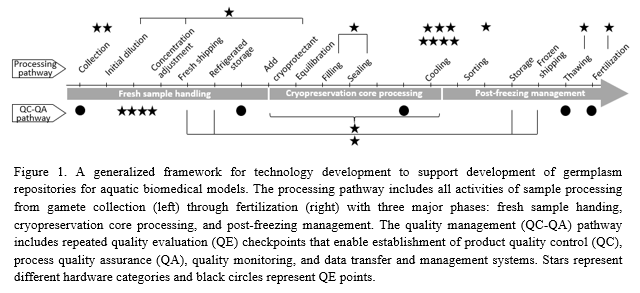OPEN HARDWARE TO FACILITATE DEVELOPMENT OF GERMPLASM REPOSITORIES FOR AQUATIC BIOMEDICAL MODELS
Development of efficient and reliable germplasm repositories is critical for preservation of genetic resources of aquatic model organisms that are vital to advancing biomedical research. However, the most significant problem in repository development is the lack of reproducibility, posing great risks of losing valuable lines developed from billions of dollars research investment. Open hardware allows users to gain access to technologies through open-sharing mechanisms and enable individual contributions for improvement to facilitate community-scale standardization that would rarely be achieved through proprietary technologies. Our work recognizes 14 categories of open hardware for a cryopreservation processing pathway, and 6 categories for a corresponding quality management pathway to address the two impediments to establishing repositories among resource centers and research communities (Figure 1). Although cryopreservation protocols have been established through basic biological research, low quality samples are often produced that cannot be revived because of a lack of affordable, standardized, and reliable hardware to process samples along a production pathway. In addition, there are currently no cost-effective hardware options to enable quality management, including quality assessment for accurate evaluation, quality assurance mechanisms for prevention of defects, and quality control for elimination of inferior materials. Although some of these issues can be alleviated by commercial solutions, most laboratories are not willing to purchase expensive equipment (that can cost tens of thousands of dollars) when germplasm banking is not a focus or obligation of their work. Through open hardware, individuals can fabricate standardized devices in-house with low cost, offering opportunities to begin or improve germplasm preservation, and facilitate repository development with community efforts through aggregated high throughput.
